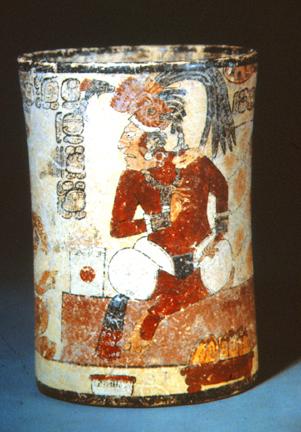
Seated Maya Lord receiving tribute
Cylindrical vessel, earthenware with polychrome slips , Guatemala
Classic Maya period, 750 CE
ART 198 - HISTORY OF WORLD CERAMICS
| An enthroned lord, seated on a stone bench greets 2 persons who hold bouquets of flowers as a tribute gift. The lord wears a hipcloth, jade jewelry (necklace, bracelets, and earplugs), and an elaborate headdress of quetzal feathers and water lilies. The scene depicts a tribute. When dignitaries visited distant cities they would arrive bearing flower bouquets and cacao (chocolate). This tradition was documented by the Spanish in the 16th century. The primary standard sequence (PSS), a standard dedication sequence of hieroglyphics can be seen at the rim, and to the left of the seated figure. This PSS records the date, purpose, maker, and recipient and usually reads something like: 'came into being, was blessed, its surface, its writing. His drinking vessel for his Naranjo frothy cacao. . great lineage member, youth, ruler, and title.' Often the name of maker is included, and in this case, the hieroglyphs for the name of the artist are placed above those of the seated ruler, indicating the high status of the artist/scribe. Below and to the right of the ruler is placed a footed bowl, filled with tamales. The tamales are covered with a blisteringly hot sauce, called achiote, still in use in Maya lands today. The simple form of the cylinder, used so often by the Maya artist to record events of the day, is reminiscent of the standard set of forms used by the Greeks on their pottery. Like the Greek vertical amphora, this form presents an uninterrupted canvas for the artist. To create imagery, the Mayan artist relied on a dark contour line over a light background color. Maya art is essentially two dimensional, using a ground line, with the background having little, if any, depth. Depth is usually indicated by overlapping shapes, such as seen here, where the bowl of tamales is in front of the stone bench, and the figure's left foot is draped in front of the bench. Note also that the figure is painted with different skin tones on his feet, face, and hands. This probably indicates body painting or tatooing. The Maya artist also learned how to created variations in hue by creating washes from the standard four slip colors. For example, here we see several different values of the dark brick red color, made by diluting the iron oxide slip with successively more amounts of water to create the lighter and more transparent shades of brown and yellow. The facial features that are seen on Maya pottery reveal many variations, indicating the attempt at portraiture. Hands are usually drawn in highly stylized positions, but the meaning of these gestures is unclear. | Seated Maya Lord receiving tribute Cylindrical vessel, earthenware with polychrome slips , Guatemala Classic Maya period, 750 CE |
|
|